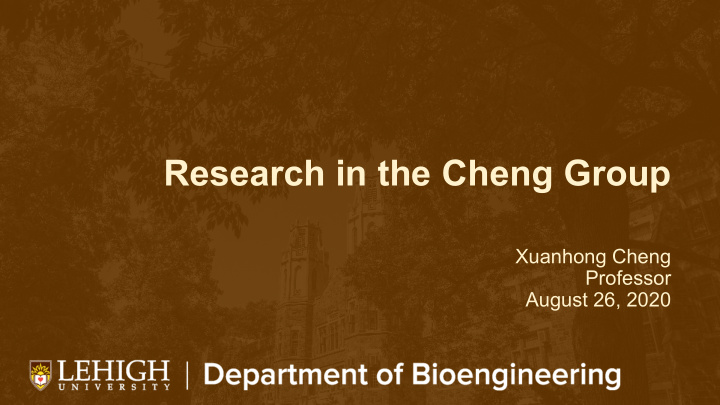



Research in the Cheng Group Xuanhong Cheng Professor August 26, 2020
Xuanhong Cheng • Professor, Bioengineering, Materials Science and Engineering, Lehigh University • Education and Training • Postdoctoral Fellow, Massachusetts General Hospital, Harvard Medical School, Boston, MA • Ph.D., Bioengineering, University of Washington, Seattle, WA • B.S., Biology, Wuhan University, Wuhan, China • Research Areas • Microfluidics, Lab on a Chip, Point-of-Care Diagnostics, BioMEMS, Biosensors, Biomaterials • Sample Publications • Yi Wang et al., “Shear-Induced Extensional Response Behaviors of Tethered von Willebrand Factor,” Biophysical Journal , 116(11), 2092-2102 (2019). • Hang Li et al., “Differentiation of Live and Heat-killed E. coli by Microwave Impedance Spectroscopy,” Sensors and Actuators B: Chemical , 255 (Part 2), 1614-1622 (2018).
Von Willebrand Factor (vWF) under Flow and Artificial vWF (in Collaboration with Frank Zhang) • What are the aims? • To understand biomechanics and function of VWF, a clotting factor responsive to high shear • To develop artificial molecules mimicking the shear response of VWF • Why is this topic significant? • Fundamental understanding of VWF diseases (VWD) • Instrumental for development of diagnostics and therapeutics • Novel drug carriers • How is the topic studied? • Single molecule characterization by force microscopy, microfluidics and optical microscopy • Brownian dynamics simulation • What are the future directions of this research? • vWF responses to physiological flow • Drug carrier for model diseases
Broadband Electrical Sensing of Cell Physiology • What is the technology? • Micro-sensors for analyzing nuclear changes and metabolic activities of single cells • Why is this topic significant? • An alternative to conventional optical and molecular analysis c) • Potential for portable, automated and high-throughput systems for point-of-care single cell analysis • What are the target Diseases? • Cancer • Chronic fatigue syndrome • What are the future directions of this research? • Theory of bioelectrics of single cells • Validation using clinical samples
Cheng Group: Lab of Micro- and NanoTechnology for Diagnostics and Biology Live Cell Function Nanomaterials for Affinity Separation Analyte 1 µ m 100 µ m Separation (b) and Concentr. Bacteria Viability Field-driven Viral Enrichment Analyte Sensing Cells and Biomolecules under Flow Virus Detection Signal Concentration and Composition Thermal OCT Imaging Excitation Processing Inlet 500 nm Main Outlet Scattering Side Outlet Scattering Side Outlet 50 µ m Concentration and Size
Contact • Professor Xuanhong Cheng Address: 5 E. Packer Ave, Bethlehem, PA, 18018 Office: 610-758-2002 Fax: 610-758-4244 Email: xuc207@Lehigh.edu Webpage: https://wordpress.lehigh.edu/xuc207/
Recommend
More recommend